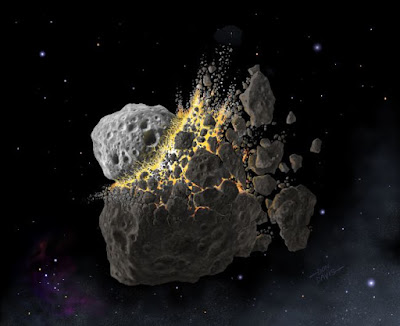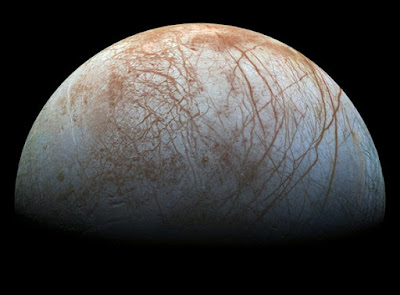 |
| An artist's depiction of an asteroid collision in outer space.(Image: © Don Davis, Southwest Research Institute) |
Topics: Asteroids, Astrobiology, Planetary Exploration, Planetary Science
"We are made of star stuff." Carl Sagan
Consider the possibility that an asteroid may have transformed the picture of life on Earth — but forget the dinosaurs and the massive crater, and rewind an extra 400 million years from that dramatic moment.
Back then, life was primarily an oceanic affair and backbones were the latest in arrival on the anatomy scene. But unlike the asteroid that killed the dinosaurs 66 million years ago, this earlier space rock never made it to Earth. Instead, a collision in the asteroid belt flooded the solar system with so much dust that, given some other changes at the time, allowed life on Earth to flourish, new research suggests.
"Most important events in the history of life are like that," said Rebecca Freeman, a paleontologist at the University of Kentucky who specializes in this period but wasn't involved in the new research. "You get a really unique set of circumstances that all come together, and you get a really dramatic event that maybe seems like it should be due to one particular dramatic thing. But in reality, it's a more complicated system at play," she told Space.com.
The dramatic event scientists want to explain is a spree of new species. That outburst of life, which paleontologists call the Great Ordovician Biodiversification Event, took place in the oceans, which were inhabited mostly by spineless creatures. "This is really a world that is dominated by invertebrate marine organisms," Freeman said. "Probably the top predator would have been a cephalopod," likely an ancestral relative of today's chambered nautilus, with its intricate spiral shell.
But when Birger Schmitz, a geologist at Lund University in Sweden, went hunting for rock dating back 466 million years, he wasn't hoping to find fossilized nautiluses; he was looking for fossilized meteorites. And over the past couple of decades, he and his colleagues have found dozens of these fossilized meteorites in a Swedish limestone quarry. Each carries a chemical time stamp indicating that it was heated about 470 million years ago, and scientists have thought for a while that there might have been a massive asteroid collision around that time.
Asteroid Dust Triggered an Explosion of Life on Earth 466 Million Years Ago
Meghan Bartels, Space.com
